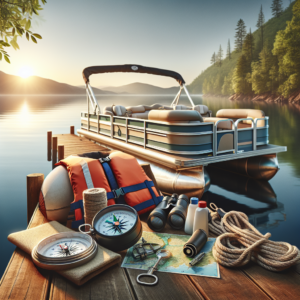Introduction to Pontoon Boating
Are you interested in pontoon boating but don’t know where to start? This beginner’s guide will provide all the essential information you need to know before hitting the water with your pontoon boat. The appeal of pontoon boats is that they offer both comfort and versatility, making them ideal for a wide range of activities such as fishing, cruising, and entertaining guests.
Understanding the Appeal of Pontoon Boats
Pontoon boats are designed with a flat deck, which makes them spacious and comfortable for passengers. They are ideal for those who want to enjoy the scenic views while on the water. Additionally, pontoon boats come equipped with amenities such as swim decks, lounge areas, barbecue grills, and sound systems. These features provide the perfect environment for entertaining family and friends.
Types of Pontoon Boats and Their Uses
There are various types of pontoon boats available in the market, from luxury pontoons with high-end features to basic pontoons suitable for fishing and small gatherings. Each type serves a different purpose and comes at a different price point. You should determine your budget and the intended usage of the pontoon boat before investing in one.
Safety Measures and Legal Requirements for Operating a Pontoon Boat
Operating a pontoon boat requires you to adhere to legal regulations and safety measures to ensure that everyone on board is safe. It is crucial to obtain a boating license and insurance, conduct a safety inspection of the boat before departure, wear life jackets, and maintain a safe speed. Following these guidelines will ensure that you have a safe and enjoyable pontoon boating experience.
Preparing for Your Pontoon Boat Trip
Preparing for your pontoon boat trip is crucial to having an enjoyable and safe boating experience. Below is a checklist of essential items to bring on board:
- Life jackets for all passengers
- Throwable flotation device (required by law)
- First-aid kit
- Fire extinguisher (required by law)
- Anchor and line
- Bimini top or sun shade
- Portable cooler with drinks and snacks
- Waterproof bag for cell phone and valuables
- Map or navigation chart
- Spare fuel tank or fuel stabilizer
Before departing, it’s important to inspect your pontoon boat to ensure it’s in good condition:
- Check that all lights are functioning properly
- Inspect the hull for any damage or leaks
- Check the fuel level and engine oil
- Make sure the battery is charged
- Test the horn and other safety devices
Weather conditions and water traffic are also factors to consider before heading out on the water. Check the forecast for the day of your trip and avoid boating during inclement weather or high winds. Keep an eye on other boats in the area and be mindful of water traffic rules and regulations.
Remember to also bring sun protection such as hats, sunglasses, and sunscreen to avoid sunburn and stay comfortable during your trip. With these preparations, you can have a safe and enjoyable pontoon boat trip!
Basic Operations of a Pontoon Boat
When it comes to operating a pontoon boat, it’s essential to have a clear understanding of the basics. This includes starting the engine, controlling speed, and properly anchoring and docking the vessel.
Starting the Engine and Leaving the Dock
Before starting the engine, make sure to untie all ropes and clear any obstructions around the boat. Once you’re ready, turn the key to start the engine and shift into forward or reverse, depending on your desired direction. Gradually increase throttle and steer the boat away from the dock.
Controlling Speed and Steering Fundamentals
Speed control is critical while operating a pontoon boat, especially in crowded areas. You can adjust speed using the throttle, and slowing the boat down can be achieved by shifting the gear into neutral. Steering a pontoon boat is relatively straightforward, and it’s important to note that the boat’s response time may vary depending on its size and weight.
Anchoring and Docking Techniques
Anchoring a pontoon boat is a straightforward process, but it’s essential to follow safety guidelines closely. Firstly, determine the depth of the water where you plan to anchor and select an appropriate anchor size. Once you’ve found a suitable location, lower the anchor and let out enough chain or rope to ensure the boat remains secure. When docking, approach the dock slowly and use fenders to protect your boat’s sides. Tie the boat securely to the dock once you’ve stopped the engine.
By understanding the basics of pontoon boat operation, you can safely enjoy your journey. Make sure to practice with a knowledgeable individual before taking your first solo voyage and always abide by local boating laws and regulations.
Navigating Waters Safely
Safe navigation is crucial when operating a pontoon boat. As an operator, you need to be familiar with reading nautical charts and interpreting buoy markers and waterway signs to avoid collisions and accidents. Here are some tips to help you navigate waters safely:
Reading and Understanding Nautical Charts
Nautical charts provide useful information on water depths, landmarks, and navigational hazards. They also show you the location of buoy markers, channels, and other important waterway features. To read and understand nautical charts, you should:
- Learn the basics of chart symbols and abbreviations
- Identify potential hazards such as rocks, shoals, and shallows
- Use latitude and longitude coordinates to pinpoint your location
- Use a compass to determine headings and bearings
Interpreting Buoy Markers and Waterway Signs
Buoy markers and waterway signs provide important information on water conditions, navigational hazards, and watercraft restrictions. Here are some common types of buoy markers and their meanings:
| Buoy Marker | Meaning |
|---|---|
| Red triangular buoy | Indicates a navigational hazard or danger |
| Green cylindrical buoy | Indicates a safe passage or navigable waterway |
| Yellow diamond-shaped buoy | Indicates caution or a change in water conditions |
| White spherical buoy | Indicates an information or regulatory marker |
Waterway signs, on the other hand, include speed limit signs, no-wake zone signs, and other traffic regulations. It’s essential to understand and follow these signs to avoid colliding with other watercraft or damaging the environment.
Handling the Pontoon Boat in Different Water Conditions
Pontoon boats can handle a variety of water conditions, depending on their size and design. However, as a captain, you need to be prepared for different scenarios and adjust your boating techniques accordingly. Here are some tips:
- In choppy or rough waters, slow down and keep your boat level to avoid pitching.
- In narrow channels or crowded areas, maintain a safe distance from other boats and follow traffic regulations.
- In heavy wind or current, use your throttle and steering to keep your boat on course.
- In shallow waters, keep your propeller clear of rocks, weeds, and sandbars.
By following these tips, you can navigate waters safely and enjoy your pontoon boating experience.
| Data Points | Description |
|---|---|
| Reading and Understanding Nautical Charts | Provide information on water depths, landmarks, and navigational hazards. They also show the location of buoy markers, channels, and other important waterway features. |
| Interpreting Buoy Markers and Waterway Signs | Buoy markers and waterway signs provide important information on water conditions, navigational hazards, and watercraft restrictions. |
| Common types of Buoy Markers | Red triangular buoy: indicates a navigational hazard or danger. Green cylindrical buoy: indicates a safe passage or navigable waterway. Yellow diamond-shaped buoy: indicates caution or a change in water conditions. White spherical buoy: indicates an information or regulatory marker. |
| Handling the Pontoon Boat in Different Water Conditions | Pontoon boats can handle a variety of water conditions, depending on their size and design. However, as a captain, you need to be prepared for different scenarios and adjust your boating techniques accordingly. |
Advanced Pontoon Boat Handling
Maneuvering Through Tight Spaces and Crowded Areas
Handling pontoon boats in tight spaces and crowded areas requires some skill and patience. Here are some tips to help you navigate through these situations:
- Always keep a lookout for other boats, swimmers, and obstacles that may be in your way.
- Slow down when entering or leaving crowded areas.
- Practice docking and maneuvering in tight spaces before you attempt it in a crowded area.
- Use fenders to protect your boat from scratches or damage when docking.
- Be mindful of the wind and current as they can affect the way your boat handles in tight spaces.
Tips for Efficient Fuel Management
Pontoon boats are known for their fuel efficiency, but there are still ways to conserve fuel and save money. Here are some tips to help you manage your fuel:
- Maintain a steady speed and avoid unnecessary idling or accelerating.
- Reduce weight on the boat by taking only what you need for your trip.
- Consider installing a fuel flow meter to monitor your fuel consumption.
- Choose the right propeller for your boat, as a propeller that is too large or too small can reduce fuel efficiency.
- Keep your boat properly maintained, as a well-maintained boat is more fuel-efficient.
Maintenance Tips to Keep Your Pontoon Boat in Top Condition
Maintaining your pontoon boat is essential to ensure it continues to operate smoothly and safely. Here are some maintenance tips to keep your boat in top condition:
- Clean your boat regularly, including the upholstery, carpet, and decks.
- Check the battery and electrical system regularly to make sure they are functioning properly.
- Inspect your boat’s propeller and replace it if it is damaged or worn.
- Change the oil and oil filter at least once a year or every 100 hours of operation.
- Inspect the hull for any damage or cracks, and repair them as soon as possible.
Frequently Asked Questions
Can I operate a pontoon boat without a license?
It depends on the state and the size of the boat. In some states, you may need a boating license or a boating safety certificate to operate a pontoon boat. If you are unsure, check with your state’s boating laws and regulations.
What is the maximum speed of a pontoon boat?
The maximum speed of a pontoon boat depends on the size of the boat and the engine. Most pontoon boats have a top speed of around 25 to 30 miles per hour, but some larger models with more powerful engines can go faster.
How often should I perform maintenance on my pontoon boat?
You should perform routine maintenance on your pontoon boat at least once a year, or every 100 hours of operation. This includes changing the oil and oil filter, inspecting the battery and electrical system, and checking the hull for any damage or cracks.







